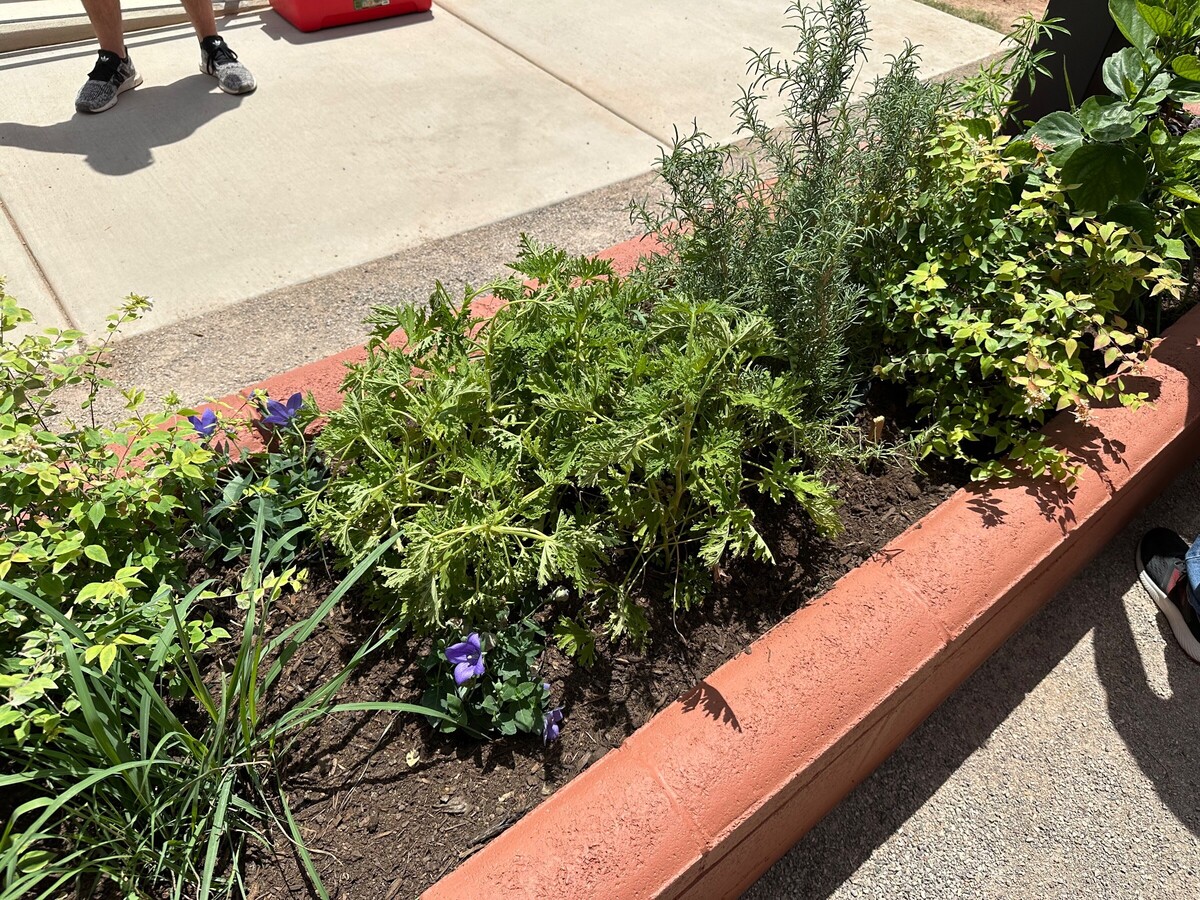Image


It's hard to believe that it’s already September! While some in Alamogordo might consider it the height of midsummer, others might feel that summer is winding down as school has just restarted. Regardless of your perspective, this is a good time for reflection.
This summer has been quite busy for me. I attended a meditation retreat, made new friends, did community service, and visited the new Sensory Garden at the New Mexico School for the Blind and Visually Impaired. I was fortunate to be there for the ribbon-cutting ceremony on July 18th. For those unfamiliar, the Sensory Garden was the brainchild of Angel Sanchez, a student at the school with a passion for landscaping and design.
Encouraged by the school, Angel set out to create a sensory garden, a space about the size of an average main bedroom. His design included an overhead canopy, a bench, herb planters lining the garden, and a water feature along the edge. Although Angel couldn’t complete the project before graduating, the 29th Attack Squadron of the 49th Division of the Air Force, known as the Ghost Warriors, stepped in to bring his vision to life, breaking ground on campus and constructing what Angel had envisioned.
As someone who is blind, I’d like to share my experience of the sensory garden. The garden is primarily for the students, but they invited the public to the ribbon-cutting ceremony. Those attending included people connected to the School for the Blind, the New Mexico Commission for the Blind Orientation Center, Downtown, the Chamber of Commerce, City Hall, and the Air Force.
Stepping into the garden, I was reminded of a similar space at the Washington State School for the Blind—a water feature near a gazebo where I spent time during summer programs, enjoying the small slice of natural beauty on campus. In contrast to New Mexico's sparse grass, Washington's climate kept the campus green most of the year, thanks to frequent rain. I cherished the shade of the gazebo and the sound of water bubbling in the fountain, and Angel’s Garden brought those memories flooding back.
I've always been fascinated by the medicinal and culinary properties of plants. As a child, I explored herbal remedies and self-care products, but I wish I had touched more fresh herbs back then. The herbs in this sensory garden are meant to be touched—they’re sturdy enough to handle contact with skin oils. They’re also meant to be smelled and, in some cases, even tasted.
Each herb is marked with a braille tag, though I found the tags challenging to read. The tags seemed to be made from wood or a similar material, with puff paint or acrylic forming the braille letters. The dots were spaced and sized in a way that made them difficult to recognize, reminding me of the braille trail in Cloudcroft, where some dots have worn away due to exposure. I wonder if 3D-printed braille tags might be a better solution, ensuring the dots are properly sized and durable enough to withstand the elements.
Despite the challenges with the tags, exploring the herbs in the garden was a delight. Given the number of people there, I didn’t get much time to feel them, but the water feature quickly became the main attraction. Just outside the garden canopy, the feature consists of a globe on the ground, with water flowing up through the center and cascading down ridges along its surface. The globe’s ribbed texture, combined with the water, reminded me of a river flowing over rocks. The water feature isn’t particularly loud, designed more for a gentle trickle, and it’s meant to be touched. There are no barriers around it, allowing visitors to walk up and explore it by feel.
As I enjoyed the water feature, I began to wonder about its maintenance, especially regarding water usage. When I was younger, I remember struggling with a geometry project that involved designing a sprinkler system for an oddly shaped property. Like many blind children, I found it challenging because we often don’t have the same opportunities to develop spatial skills. These skills are crucial for tasks like navigation and arranging spaces accessibly. It’s fantastic that Angel had the opportunity to develop his spatial abilities through this project, and I’m grateful that the Ghost Warriors helped complete it.
Looking ahead, I hope the sensory garden will continue to serve as an educational tool for the School for the Blind. I imagine students taking responsibility for its upkeep—planting herbs on time, pulling weeds, maintaining braille tags, keeping the area clean, and caring for the water feature. These tasks could teach valuable skills, including spatial awareness, cleaning, yard work, planning, and community service. I envision older students taking on the responsibility of caring for this unique campus feature.
If you want to learn more about the sensory garden, I’ve attached a link to an article written by Air Force personnel with photos. While I’m not sure if the Sensory Garden is open to the public, the school sometimes opens its campus for events like the Luminaria near the holidays. That might be a perfect time to visit the garden, or perhaps during the spring and summer seasons if it’s ever open to visitors.
Whatever the rest of your summer may bring, I hope you stay well and Alamogorgeous!
Acknowledgments
I’d like to extend my gratitude to the AIs that assisted with the editing of this article. These AIs, developed by OpenAI and PLAUD, reflect the growing capabilities of artificial intelligence in supporting organic creativity. For more information about PLAUD and OpenAi, as well as a link to the sensory garden article published by the US Air Force, please visit the following.
Ghost Warriors Hold Ribbon-Cutting Ceremony at School for the Blind; and article written by Bob Teichmann: https://www.aetc.af.mil/News/Article-Display/Article/3845350/ghost-warriors-hold-ribbon-cutting-ceremony-at-school-for-the-blind/
PLAUD NOTE: https://www.plaud.ai/products/plaud-note-ai-voice-recorder
OpenAI: https://openai.com/